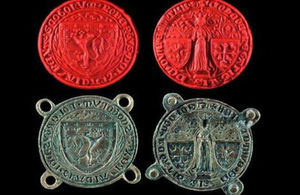Rare Scottish seal matrix at risk of leaving the UK
Arts minister steps in to prevent unique object from export.

A rare two-part Scottish seal matrix
Arts Minister John Glen has placed a temporary export bar on a Scottish two-part seal matrix to provide an opportunity to keep it in the country.
The seal matrices are at risk of being exported from the UK unless a buyer can be found to match the asking price of £151,250.
The front is engraved with St Margaret, Dunfermline Abbey’s founding saint, and the reverse bears the royal arms of Scotland. It carries an inscription that translates as “Robert, by the Grace of God, King of the Scots”.
It is thought that the seal matrix pair could date back to the the reign of Robert I, King of Scotland, known as Robert the Bruce, although some experts believe it could be a later replica of a lost original from the late Middle Ages.
Arts Minister John Glen said:
This incredibly rare item is of outstanding significance to the study of seals, and is all the more fascinating for its potential association with Robert the Bruce.
I hope that a buyer comes forward to help keep this unique object in the UK so we may learn more about its history.
The decision to defer the export licence follows a recommendation by the Reviewing Committee on the Export of Works of Art and Objects of Cultural Interest RCEWA, administered by The Arts Council. It was previously subject to an export deferral in 2016, which was suspended to allow new information about its history to be considered.
RCEWA member Leslie Webster said:
This remarkable two-part seal matrix is unique, and if it indeed dates to the reign of Robert the Bruce (1306-1329) it is an item of outstanding importance, as one of the few objects directly associated with his reign, a decisive period in the history of the Kingdom of Scotland.
An alternative possibility, that it might be a later copy of a lost original, does not diminish its considerable significance for the study of medieval seal-dies, and opens up new avenues of research.
The RCEWA made its recommendation on the grounds of the seal’s outstanding significance to Scottish antiquarianism and sigillography (the study of seals).
The decision on the export licence application for the seal will be deferred until 24 November 2017. This may be extended until 24 February 2018 if a serious intention to raise funds to purchase it is made at the recommended price of £151,250.
Offers from public bodies for less than the recommended price through the private treaty sale arrangements, where appropriate, may also be considered by John Glen. Such purchases frequently offer substantial financial benefit to a public institution wishing to acquire the item.
Organisations or individuals interested in purchasing the seal should contact the RCEWA on 0845 300 6200.
Images of the seal matrix pair can be downloaded via our flickr site.
For media information contact: Yasmin Kaye Communications Officer Department for Culture Media and Sport Tel: 0207 211 6489 Email: [email protected]
Notes to editors
- Details of the seal are as follows: A two-part cokete seal matrix for the Abbey of Dunfermline, within a 19th century presentation box. The matrices are made of copper alloy, in a wooden presentation box. Each matrix is 55mm in diameter, weight 337 grams. Date unknown.
- The Reviewing Committee on the Export of Works of Art and Objects of Cultural Interest is an independent body, serviced by The Arts Council, which advises the Secretary of State for Culture, Media and Sport on whether a cultural object, intended for export, is of national importance under specified criteria.
- The Arts Council champions, develops and invests in artistic and cultural experiences that enrich people’s lives. It supports a range of activities across the arts, museums and libraries – from theatre to digital art, reading to dance, music to literature, and crafts to collections. www.artscouncil.org.uk.